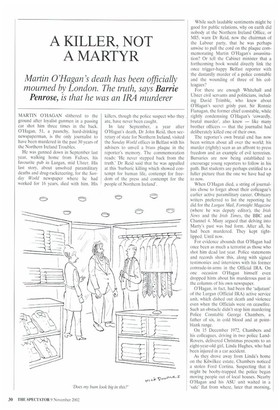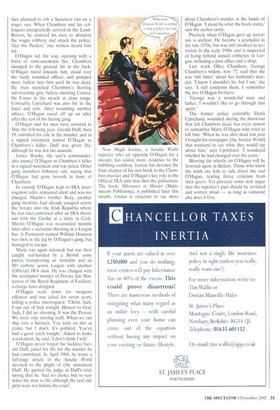A KILLER, NOT A MARTYR
Martin O'Hagan's death has been officially
mourned by London. The truth, says Barrie Penrose, is that he was an IRA murderer
MARTIN O'HAGAN slithered to the ground after loyalist gunmen in a passing car shot him three times in the back. O'Hagan, 51, a paunchy, hard-drinking newspaperman, is the only journalist to have been murdered in the past 30 years of the Northern Ireland Troubles.
He was gunned down in September last year, walking home from FaJoes, his favourite pub in Lurgan, mid Ulster. His last story, about unsolved paramilitary deaths and drug-racketeering, for the Sunday World newspaper where he had worked for 16 years, died with him. His
killers, though the police suspect who they • are, have never been caught.
In late September, a year after O'Hagan's death, Dr John Reid, then secretary of state for Northern Ireland, visited the Sunday World offices in Belfast with his advisers to unveil a brass plaque in the reporter's memory. The commemoration reads: He never stepped back from the truth.' Dr Reid said that he was appalled at this 'barbaric killing which showed contempt for human life, contempt for freedom of the press and contempt for the people of Northern Ireland'. While such laudable sentiments might be good for public relations, why on earth did nobody at the Northern Ireland Office, or MI5, warn Dr Reid, now the chairman of the Labour party, that he was perhaps unwise to pull the cord on the plaque commemorating Martin O'Hagan's assassination? Or tell the Cabinet minister that a forthcoming book would directly link the once trigger-happy Belfast reporter with the dastardly murder of a police constable and the wounding of three of his colleagues?
For there are enough Whitehall and Ulster civil servants and politicians, including David Trimble, who knew about O'Hagan's secret grisly past. Sir Ronnie Flanagan, the former chief constable, while rightly condemning O'Hagan's 'cowardly, brutal murder', also knew — like many brother officers — that the journalist had deliberately killed one of their own.
The reporter's own brutal end has now been written about all over the world; his murder (rightly) seen as an affront to press freedom and an example of evil terrorism. Bursaries are now being established to encourage young reporters to follow in his path. But students are perhaps entitled to a fuller picture than the one we have had up to now.
When O'Hagan died, a string of journalists chose to forget about their colleague's earlier active paramilitary career. Obituary writers preferred to list the reporting he did for the Lurgan Mail, Fortnight Magazine (where he was deputy editor), the Irish News and the Irish Times, the BBC and Channel 4. Many argued that delving into Marty's past was bad form. After all, he had been murdered, They kept tightlipped. Until now.
For evidence abounds that O'Hagan had once been as much a terrorist as those who shot him dead last year. Police statements and records show this, along with signed testimonies and interviews with his former comrade-in-arms in the Official IRA. On one occasion O'Hagan himself even dropped hints about his murderous past in the columns of his own newspaper.
O'Hagan, in fact, had been the 'adjutant' of the Lurgan (Official IRA) active service unit, which dished out death and violence even when the Officials were on ceasefire. Such an obstacle didn't stop him murdering Police Constable George Chambers, a father of six, in cold blood and at pointblank range.
On 15 December 1972, Chambers and his colleagues, driving in two police LandRovers, delivered Christmas presents to an eight-year-old girl, Linda Hughes, who had been injured in a car accident.
As they drove away from Linda's home on the Kilwilkee estate, Chambers noticed a stolen Ford Cortina. Suspecting that it might be booby-trapped the police began moving people out of local houses. Nearby O'Hagan and his ASU unit waited in a 'safe' flat from where, later that morning, they planned to rob a Securieor van on a wages run. When Chambers and his colleagues unexpectedly arrived in the LandRovers, he ordered his men to abandon the wages robbery and attack the police. 'Get the Peelers,' one witness heard him say.
O'Hagan led the way, opening with a burst of semi-automatic fire. Chambers slumped to the ground, hit in the hack. O'Hagan raced towards him, stood over the badly wounded officer, and pumped more bullets into him until he was dead. He then snatched Chambers's Sterling sub-machine gun, before shooting Constable Foster in the mouth at close range. Constable Uprichard was also hit in the hand and arm. After wounding another officer. O'Hagan raced off up an alley after the rest of his fleeing gang.
O'Hagan and his men were arrested in May the following year. Gerald Duff, then 19, admitted his role in the murder, and in a signed statement named O'Hagan as Chambers's killer. Duff was given life, although he was not the assassin.
James Shanks, the unit's commander, also named O'Hagan as Chambers's killer in a signed statement and was jailed. Other gang members followed suit, saying that O'Hagan had gone berserk in front of Chambers.
In custody O'Hagan kept to IRA interrogation rules, remained silent and was not charged. Martin's brother Rory, another gang member, had already escaped across the border into the Irish Republic where he was later convicted after an IRA shootout with the Gardai at a dairy in Cork. Martin O'Hagan was re-arrested months later after a sectarian shooting in a Lurgan bar. A Protestant named William Houston was shot in the leg by O'Hagan's gang, but managed to escape.
Marty was again released, but was then caught red-handed by a British army patrol, transporting an Armalite and an M1 carbine across Lurgan with another (Official) IRA man. He was charged with the attempted murder of Private Ian Matterson of the Royal Regiment of Fusiliers, a charge later dropped.
O'Hagan went down for weapons offences and was jailed for seven years, telling a police interrogator: 'Christ, Jack. I ran out of luck tonight. Honest to God, Jack, I did no shooting. It was the Provos. We were only moving stuff. When we ran slap into a Saracen. You look on this as crime, but I don't. It's political. You've had a good catch tonight.' Asked to make a statement, he said, 'I don't think I will.'
O'Hagan never forgot the luckless Gerald Duff, jailed for life for the murder he had committed. In April 1986, he wrote a full-page article in the Sunday World devoted to the plight of (the unnamed) Duff. He quoted the judge at Duff's trial, saying that he 'had no choice but to sentence the man to life although the real culprits were not before the court'.
Now Hugh Jordan, a Sunday World reporter who sat opposite O'Hagan for a decade, has added more evidence to the bubbling cauldron. Jordan has devoted the final chapter of his new book to the Chambers murder and O'Hagan's key role in the Official IRA unit that shot the policeman. The book, Milestones in Murder (Mainstream Publishing), is published later this month. Jordan is reluctant to say more
about Chambers's murder at the hands of O'Hagan. 'I stand by what the book states,' says the author tartly.
Precisely when O'Hagan gave up terrorism is unclear. He became a journalist in the late 1970s, but was still involved in terrorism in the early 1980s and is suspected of being behind armed robberies in Lurgan, including a post office and a shop.
Last week Olive Chambers, George Chambers's widow, now 77, said that she was 'still bitter' about her husband's murder. 'I know I shouldn't be, hut I am,' she says. 'I still condemn them. I remember the two O'Hagan brothers.
'George was a wonderful man and father. I wouldn't like to go through that The former police constable Denis Uprichard, wounded during the shoot-out that left Chambers dead, has every reason to remember Marty O'Hagan who tried to kill him. When he was shot dead last year 1 bought his newspaper [the Sunday World] that weekend to see what they would say about him,' says Uprichard. 'I wondered whether he had changed over the years.'
Blowing the whistle on O'Hagan will be frowned upon in Belfast. Those who know the truth are loth to talk about the real O'Hagan, fearing fierce criticism from their peers. Yet privately some now argue that the reporter's past should be revisited and written about — as long as someone else does it first.



















































































































 Previous page
Previous page